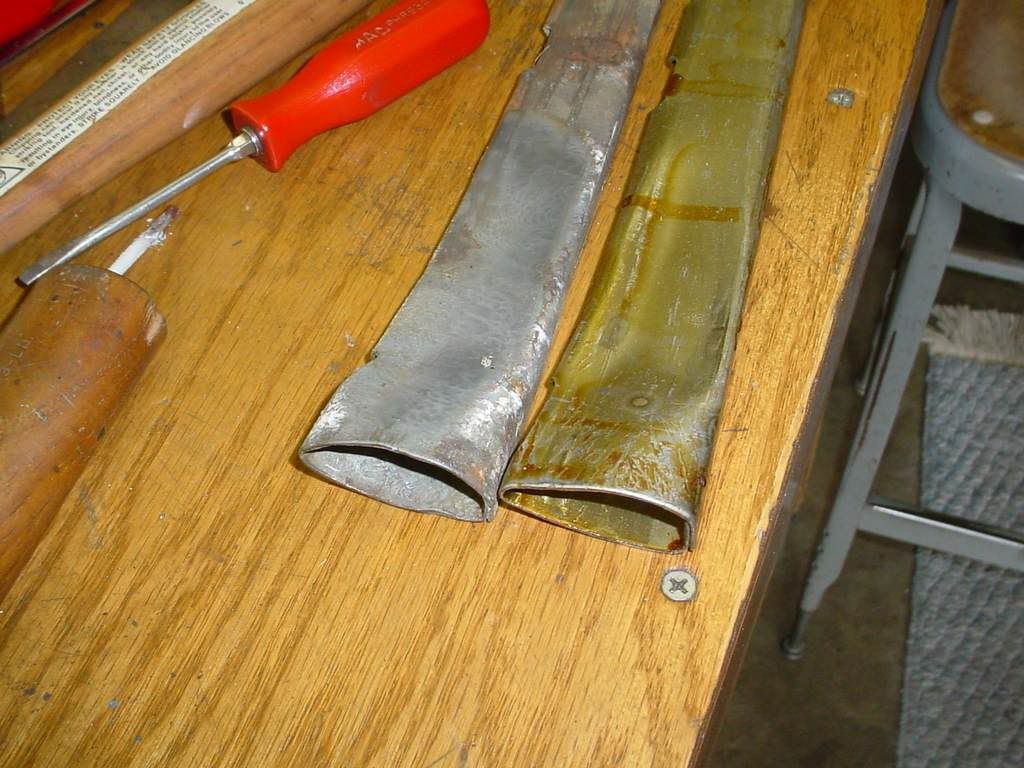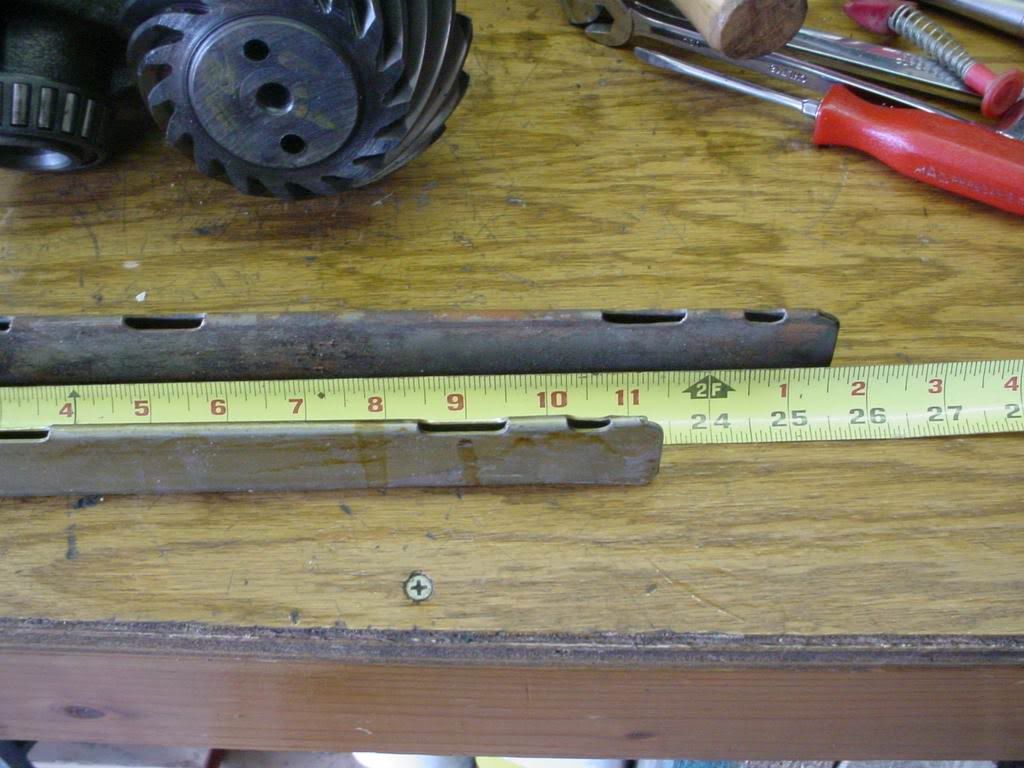|
|
Joined: Aug 2004
Posts: 44
Active BB Member
|
OP

Active BB Member
Joined: Aug 2004
Posts: 44 |
Want to here something wacky? My 230 completely wiped out my #6 rod bearing. Over the course of 5 miles it went from fine to knocking to pounding(had to get off the interstate). Here's what I found inside. the #4 main bearing was lined up properly and looked good as new, but the rod journal ended up .020" out of round, and the rod it junk. The rod bearing shells were paper thin. Oil pressure was good the whole time. I couldn't find anything in the oil gallies in the block or in the crank that could have prevented the bearing from getting oil. Why did that one spin and not 2,3,4,or 5(like i expected)?
|
|
|
|
|
Joined: Dec 2000
Posts: 3,332
1000 Post Club
|

1000 Post Club
Joined: Dec 2000
Posts: 3,332 |
That condition usually is caused from 'over reving.'
"A chain is only as strong as the weakest link".
Good luck John M.., #3370...
John M., I.I. #3370
"There are no shortcuts to any place worth going". -Anon
|
|
|
|
|
Joined: Aug 2004
Posts: 44
Active BB Member
|
OP

Active BB Member
Joined: Aug 2004
Posts: 44 |
When it happened, I was doing a constant 65 on the interstate(honest,not even speeding). I was about 30 miles into the trip at that same speed.
|
|
|
|
|
Joined: Mar 2004
Posts: 757
Major Contributor
|

Major Contributor
Joined: Mar 2004
Posts: 757 |
Check the rod bolts for stretching. How did they feel when you started to remove the bearing cap?
Has the engine been together and running for some time or has it recently been redone?
Mike G ( 4355 )
Mike G #4355
|
|
|
|
|
Joined: May 2005
Posts: 15
Active BB Member
|

Active BB Member
Joined: May 2005
Posts: 15 |
i know this sounds really strange on a bearing, but did you change out the water distribution tube? the number 6 cylinder usually fails when it is plugged up. however, i would presume that problem would be on the top end and not the bottom. just a thought, though.
|
|
|
|
|
Joined: Aug 2004
Posts: 44
Active BB Member
|
OP

Active BB Member
Joined: Aug 2004
Posts: 44 |
Motor was together for 250 miles. I put pistons and rings in it, but because it was working fine, didn't touch the bottom end. All bearings were within spec. Rod bolts seemed OK. I did remove the water distribution tube, then preasure washer blasted out the water jackets and all coolant holes in the block until no more sludge came out and the water ran clear.
|
|
|
|
|
Joined: Sep 2004
Posts: 5,840 Likes: 1
1000 Post Club
|

1000 Post Club
Joined: Sep 2004
Posts: 5,840 Likes: 1 |
Quick question, what is the water distribution tube?
Thanks
12 port SDS EFI 
|
|
|
|
|
Joined: Aug 2004
Posts: 44
Active BB Member
|
OP

Active BB Member
Joined: Aug 2004
Posts: 44 |
The water distribution tube is basically a tube that runs front to back inside the block behind the waterpump to make sure that cool water gets all the way to the back of the motor. It's roughly D shaped, as long as the engine, and has holes in it where the cylinders are. if it corrodes away, or you forget to put it in, the rear cylinders will overheat because the water won't circuate all the way to the back of the block.
|
|
|
|
|
Joined: Oct 2003
Posts: 98
Active BB Member
|

Active BB Member
Joined: Oct 2003
Posts: 98 |
Pictured are two water distribution tubes. One for a "small" block Plymouth, one for a "big" block Desoto Chrysler engine. For a good explanitation on there replacement follow this link. Scrool down in the Technical Tips section. http://www29.addr.com/~merc583/mopar/framesets/techtipframeset.html Don Coatney  
Don Coatney
|
|
|
|
|
Joined: Sep 2004
Posts: 5,840 Likes: 1
1000 Post Club
|

1000 Post Club
Joined: Sep 2004
Posts: 5,840 Likes: 1 |
Thanks for the pics,
So, these distribution tubes are in the 194, 230, 250, 292 inline Chevy engines?
I have never seen them if they are in these engines.
Thanks
Hank
12 port SDS EFI 
|
|
|
|
|
Joined: May 2000
Posts: 243
Contributor
|

Contributor
Joined: May 2000
Posts: 243 |
Hi Hank, "small" block Plymouth, one for a "big" block Desoto Chrysler engine. This how the last post in the MoPar forum started. Jim
Jim - #2130
|
|
|
|
|
Joined: Aug 2004
Posts: 44
Active BB Member
|
OP

Active BB Member
Joined: Aug 2004
Posts: 44 |
How would new pistons and rings affect rod bearings? Even if they do cause more drag on the cylinders, if the engine has good oil pressure, it should be able to handle a little extra pressure. Can you clarify any? Thanks
|
|
|
|
|
Joined: May 2005
Posts: 15
Active BB Member
|

Active BB Member
Joined: May 2005
Posts: 15 |
i'm glad to have the benefit of walt's knowledge here. i'm sorry bugman had this experience.
just about 4 days ago, i learned from an "old timer" that the chrysler flathead 6 had what he called a "soft crankshaft". this guy apparently had a lot of experience with them as a user. basically, he was saying don't push it. other than that, he didn't have anything bad to say about it.
i don't know if the "issue" was the crank or bearings, but i DO know that dodge later put a forged crank in the 251 power wagons. i would presume that the others are not. seeing as how we're talking about an engine that first went into production in 1933, i can see how my expectations of today might exceed the tolerances of yesteryear.
simply put, 50 miles per hour was a pretty good clip on the lousy roads of 1933. on the other hand, i know the engine is a stout one, given that it continued production into the 1970's in various applications.
jeff, don't give up on it!!! i don't want to lose any true believers. please bear in mind that this is still new to me, and my opinions certainly shouldn't be considered as gospel.
|
|
|
|
|
Joined: Apr 2001
Posts: 18
Active BB Member
|

Active BB Member
Joined: Apr 2001
Posts: 18 |
dodge / mopars have soft cranks after you grind about .020 under I think that dodge/mopar knew because they only sold up to .012 under bearings only. BUT if you toughride the crank this should solve the problems with the soft crank. hope this helps.
mike...
|
|
|
|
|
Joined: Aug 2004
Posts: 44
Active BB Member
|
OP

Active BB Member
Joined: Aug 2004
Posts: 44 |
I know. I just don't like it when I can't find the problem. If I found a blocked passage or something, I'd know what was wrong. Not knowing makes me nervous about the rebuild because what if it happens again. Know what I mean?
|
|
|
|
|
Joined: Jun 2005
Posts: 599
Major Contributor
|

Major Contributor
Joined: Jun 2005
Posts: 599 |
Did Bugman ever rebuild this engine?
Just looking over this, I recall being told when I was young that you never put new rings in an engine without fitting new bearings as well.
As for what to do at this stage, Tufftriding has been mentioned, sounds reasonable, and rebuild. But I guess it's already been done?
Does anyone know if there were any forged cranks made for the 230?
|
|
|
|
|
Joined: Feb 2004
Posts: 31
Active BB Member
|

Active BB Member
Joined: Feb 2004
Posts: 31 |
Did you have the main bearings and rod bearing shells out of the block and the rods? The number 1 main feeds only the number 1 rod and the number four main feeds only the number 6 rod. Rods two and three are feed from the number two main and rods four and five are fed from the number three main. Which rod bearing did you lose, you talk about number six rod and number four main and they have nothing in common. You mention that 2,3,4and 5 are ok, what about number 1. Depending who supplied the main bearing shells some have a hole in both shells and some have only one shell with a hole in it. I installed my number 1 main with the hole in the cap and the shell without a hole in the block saddle even after telling my self not to do it. Got about 40 miles on the lubrplate before the knock started. Had 50 PSI oil pressure but none to the number 1 rod.
|
|
|
|
|
Joined: Nov 2002
Posts: 166
Contributor
|

Contributor
Joined: Nov 2002
Posts: 166 |
I would like to reenforce what Jim said. Check the alignment of the hole in the block and the main bearing. They do not line up well. #1 rod and #6 rod are well oiled, if the holes in the block and main are aligned. Also check the groove depth in the bearing. If you used the old bearings they could have been worn considerable. The rear main bearing especially. The research I did before building said to make sure the holes were in alignment and also to cut the groove in the new main bearings wider and deeper.
Hope this helps.
|
|
|
|
0 members (),
125
guests, and
27
robots. |
|
Key:
Admin,
Global Mod,
Mod
|
|
|
|

